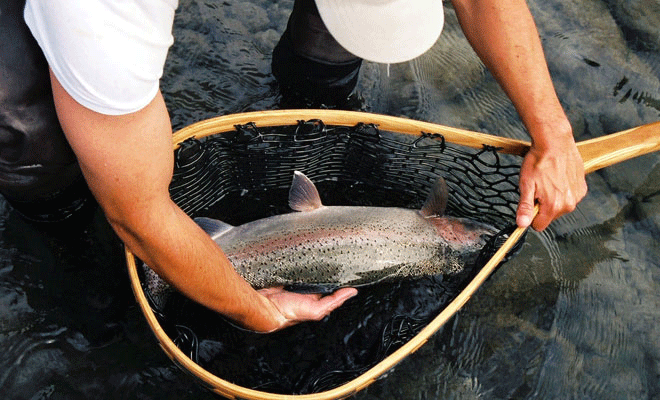Story & Photos by Jeremy Anderson
Midsummer rainbow trout fishing offers more options than any other time of year, providing variety in your fishing as well as the kind of angling challenges that can suck you right in. On a day off I can look at all the factors for the day and make a spontaneous decision on where to go fishing. There are lakes, small streams and the big rivers. If I feel like a workout I can hike into a lake somewhere. If I need to get my feet wet it is easy to find a spot to wade a small stream. If I want to be lazy and have supreme access I can fish out of a boat in a bigger river.
Variety of Food Available
In midsummer, there are many different types of food that the trout have access to—and these are very hungry fish. This doesn’t mean the trout are going to jump on the hook with anything you throw at them; you will still have to work for your bites.
It is highly desirable as an angler to have many options, and where you go will determine what you are going to want to use. You could throw dry flies, nymphs, leeches, streamers, smolt patterns, flesh flies or beads. Some days you can catch a few fish on everything, but most days there is a fly or bead that works better than most. It is your job to be prepared, have options and find out what the trout want to eat. If you aren’t catching, change it up.
One of the first things I dois set my rod down and look around at my surroundings. I want to pull in as many of the clues from the area as I can before I even wet a line. I ask myself the following questions: Is there a current and what is it doing? Are there any natural points, shallow flats or deep drop-offs in the lake (if fishing stillwater)? Are bugs flying in the air? Are the bugs landing on the water and are there any trout rising? What was last fall like and is there still old food around?
If you can’t see anything above the water put on your polarized glasses and scan the water for clues. You just might be surprised. Taking in your surroundings usually helps get an angler started in the right direction.
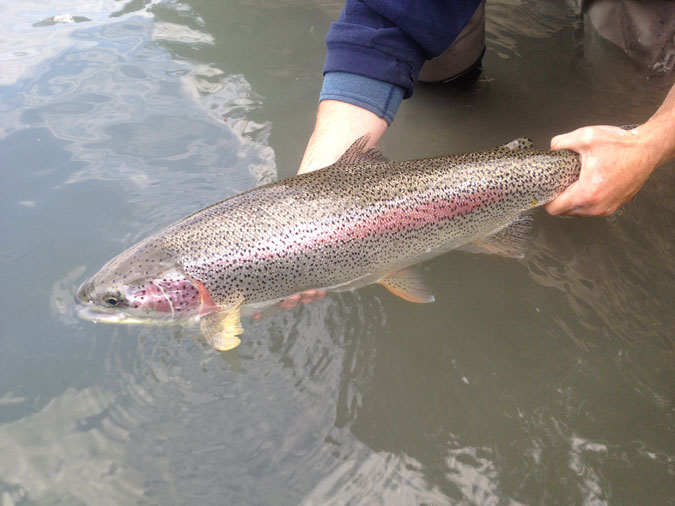 Nigel Fox shows off a fat summer rainbow trout taken from the Russian River. Above: The author displays a nice summer trout.
Nigel Fox shows off a fat summer rainbow trout taken from the Russian River. Above: The author displays a nice summer trout.
Lakes
Lake fishing for rainbow trout in the summer is awesome. It is a good feeling to get the blood pumping as you hike or bike into a lake where the reflection of the mountains may blow your mind more than the first bite of the day. I think of fishing lakes as the full experience. The Internet and countless trail books can help you target lakes that have access via hiking or biking. Researching a new place and how to access it is half the fun. Often there are State Park, Refuge or National Forest campsites or cabins available for rent. Staying overnight gives the added bonus of lying under the early-summer midnight sun. If you want to really get away and don’t mind spending some cash, you could charter an air taxi and get flown into a remote lake for single- or multi-day trips.
One trip that I really enjoy is biking on the Crescent Lake Trail out of Cooper Landing off of Quartz Creek Road. It is a relatively mellow but really fun bike ride into the lake and creek. There are a few rolling hills that help you get your biking fix in. You can target grayling, Dolly Varden and rainbow trout. I don’t go here expecting to catch any monsters but to get my rod bent, escape from the hustle and bustle of the road-system fisheries and get a good breath of fresh Alaska air. Typically a 4- or 5-weight will do the trick. Have your dry flies and nymphs with you ready to deploy.
When lake fishing, I prefer to fish the mornings or evenings. I search out access points on the lake. If possible, I want a place that I can see the depth change and have room to cast. A natural point that sticks into the lake is even better. I also make sure to look at each bug that is trying to bite me. After assessing my surroundings, I start making choices. Options for fly fishing a lake include dry flies, nymphs, streamers, leeches and smolt patterns. If you see trout rising, throw a dry fly. If you don’t see much activity at the top of the water, then get your presentation underwater. You can throw a fly and slowly let it sink, cast your line out and strip it in or employ a combination of both.
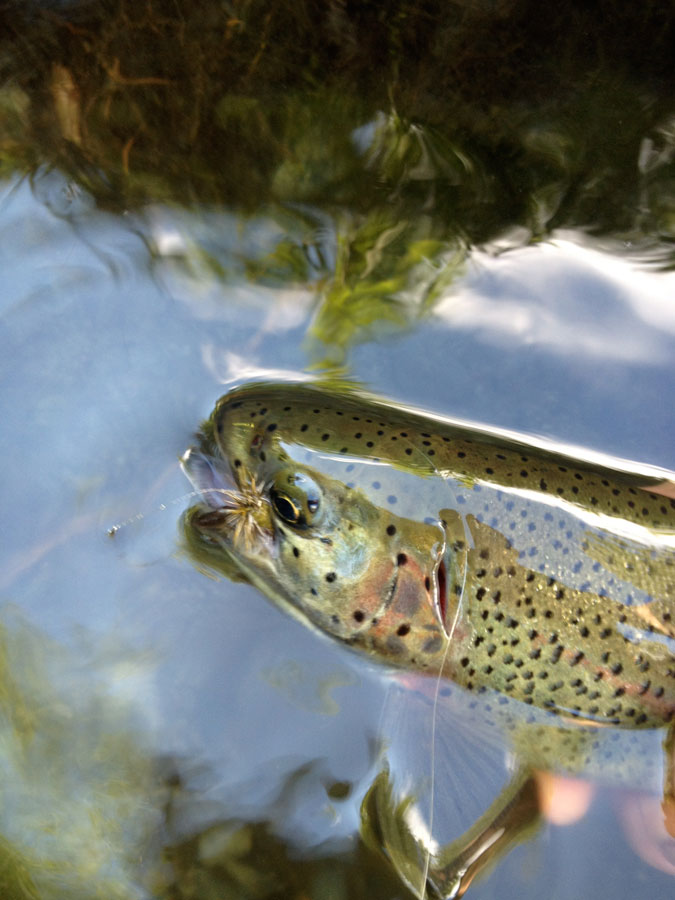
rainbow was taken on a dry fly, another perk of summer trout fishing in Alaska.
This colorful
Small Streams
Midsummer fishing in small streams is action-packed and presents many different challenges. Casting in close quarters, hitting almost unnoticeable pockets of water, drifting along logjams, and technical mending is what excites the small-stream fisherman. It reminds me of that scene in A River Runs Through It; hooking a lunker of a trout and having to Brad Pitt the fish downriver to try andkeep it on the line.
There are small streams from Valdez to Denali, the Mat-Su Valley to Anchorage and on the Kenai Peninsula. I started small-stream fishing in central Wisconsin and immediately sought it out when I moved to Alaska. My first adventure up here with was the Russian River, probably one of the most well-known small streams in Alaska. I was immediately hooked on small-stream fishing and began branching out to other streams on the Kenai Peninsula near Seward, Homer and Hope. I usually bring my 4-, 5- or 6-weight rod and always have my fly box ready with lots of options.
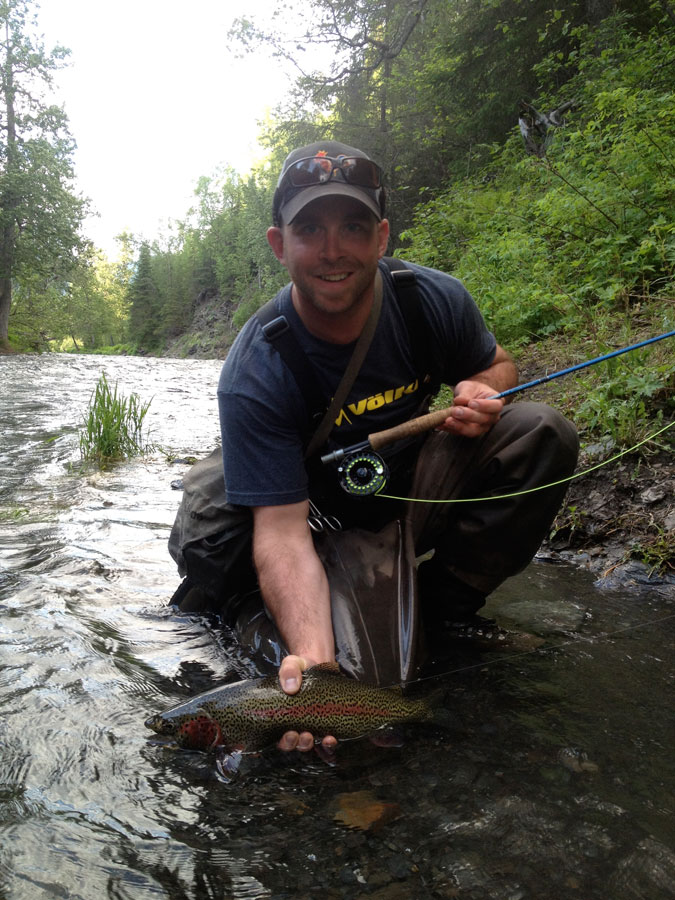
Fishing guide Nick Ohlrich is stoked with his small-stream trout caught on a nymph.
Alaska Drift Away
When small-stream fishing, I have a variety of dry flies, nymphs, flesh patterns and beads. It is important to stop by the local fly shop or hardware store and get some information on the area. If you get started in the right direction it can help take away some of the guessing. I almost always start with a nymph, unless it is very obvious that there is a hatch going on or the smell of rotting salmon fumigates the air. If the nymph isn’t working then try a few different flesh patterns and from there branch out. Eventually, you will figure out what the trout are feeding on that day.
Big Rivers
Fishing a big river, such as the Kenai, is best accomplished with a boat. It gives you quick access to all your favorite spots throughout the day. There are a lot of different things going on in a larger river, and the complexity makes it fun, challenging, rewarding and frustrating at the same time. This time of year the fishing is changing daily. In most areas the rainbow trout have just finished spawning and are recovered from that delicate process. Rainbow trout have moved back into the feeding lanes, which are changing constantly as the summer progresses. It can seem like so much water sometimes, but don’t get overwhelmed. A big river is just like a small river if you break the water into sections. Focus on one small section at a time and spend the time needed to find what you are looking for.
There are many big rivers in Alaska to target. Some of them aren’t the most accessible but there’s a way to get to all of them. You can fly into King Salmon across Cook Inlet from Anchorage and go to a fishing lodge. There are opportunities to have a floatplane drop you, your buddies and a raft off on a remote river. There are also big rivers on the road systems in the Mat-Su Valley and on the Kenai Peninsula. Most of the big roadside rivers are best fished with a local guide service, unless you have a friend with a boat who knows how to run the river. My friends, clients and family typically fish the Kenai River, a few hours south of Anchorage.
Before I put the boat in the water, it is very important to me that I find out safety concerns and get a geographical sense for where I am going. No two rivers are exactly alike; for example, the Deshka River has different navigation concerns and hazards than the Kenai or the Naknek. In big rivers I want to know where the main channel is at all times. Next I look for different structures that may change where the food supply is traveling, including rocks, drop-offs, shorelines, current breaks and funnel points. As you dissect a big water system, remember to take a deep breath and create your own unique system of covering water with a variety of options for the trout to eat. Come stacked with a variety of sizes and colors in your fly- and bead collection and keep switching until you find something that works.
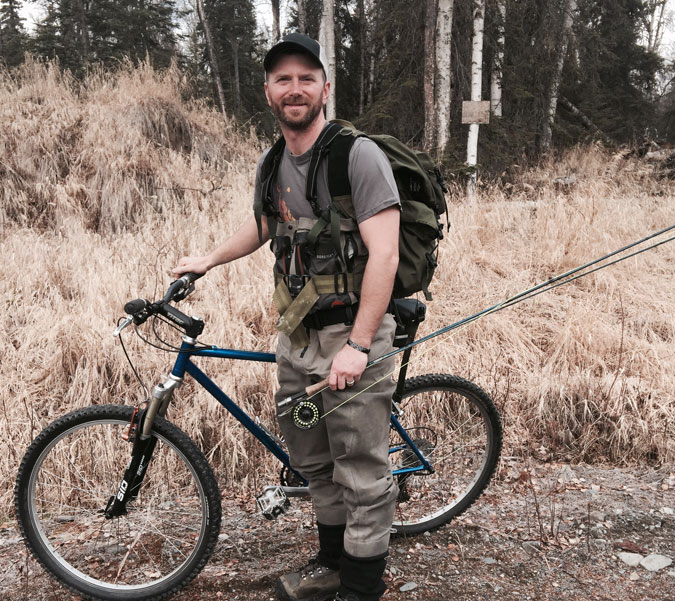
Headed for some secluded summertime angling, the author bikes to a local lake in the Sterling area for some dry-fly action.
Get More Bites
There are many ways to enhance your opportunities on the water. Gathering information before you go is important. Get online and research area maps on where you are going to fish. Look at the NOAA website for upcoming weather patterns or connect with your social media network. Stop by the local fly shop or hardware store and talk fishing. Most businesses will share the information they know and if they don’t, go somewhere else. Ask questions to get a few pieces of information that will help you put together the puzzle.
In terms of gear, there are a few basic things to consider. Make sure that the type of gear you are using is appropriate for the location you are fishing. If you are using a fly rod make sure to have floating and sinking line with you as well as a variety of different tippet sizes. If you are using a spin rod and float fishing I recommend using P-Line Hydrofloat as your mainline to give you a good drift. If you want your pattern get to the bottom faster consider using fluorocarbon. If you know your fly or bead is the right one, maybe downsize your line and hook by one size. Change up your bead or fly if you are not sure what they are biting on.
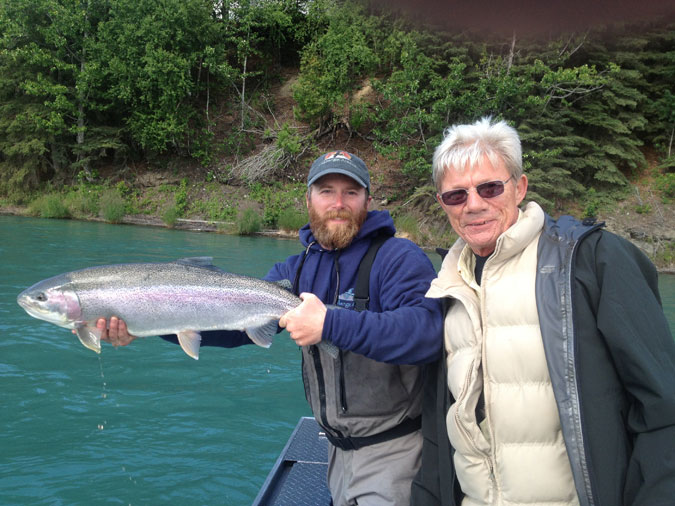
Gary Lillo with guide and author Jeremy Anderson, showing off a big female Kenai River rainbow taken in early August.
Wrapping It Up
The bottom line is that midsummer rainbow trout fishing is all about having fun outdoors while enjoying Alaska’s beauty. There are many different options that you can try, from lakes, small streams and big rivers. Each offers a different experience and gives you different things to consider. Remember to be safe and don’t venture out past your comfort level.
It is important to be respectful of others as well as the resource you are using. Make sure to find out local regulations and you are using the right equipment to keep Alaska’s rainbow trout population healthy. It’s our privilege to have access to these amazing resources, not something we can take for granted.
As your summer fishing trip plans come together I challenge you to branch out and have a new experience. Not only will it be exciting, but you will have a more well-rounded fishing mindset. Your collective experiences from a variety of fishing areas will carry over to any water you fish during any time of the year.
Jeremy Anderson, from Winneconne, WI, has lived in Alaska for more than a dozen years, all but one of them spent guiding anglers on the Kenai River to some of best trout and salmon fishing in the world, as part of the team at Alaska Drift Away Fishing. During the winter, he lives in Girdwood and works as Director for Challenge Alaska Adaptive Ski School.
This article originally appeared in the July 2015 issue of Fish Alaska.

